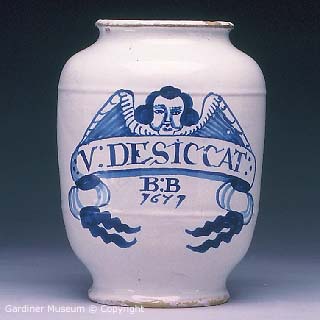The
Gardiner museum maiolica collection of is worth visiting. Here are some pill-tiles from England they have the Latin motto OPIFER:QUE:PER:ORBEM:DICOR (“I am spoken of all over the world as one who brings help.”)
source. Objects used…
in Apothecaries have a rich maiolica tradition that leads back to the development of maiolica. The Apothecary jar is the most commonly known object. They are often decorated with elaborate pattens and imagery. Here is a sneak peek of some Italian renaissance maiolica apothecary jars.
Here is a common English delft variation of the apothecary jar. Northern European jar forms varied from Persian and Southern European apothecary jars. The forms of Northern European jars often had softer, rounded forms. Personally I prefer the drawing of the images of Italian maiolica but prefer the use of negative space in many of the English jars. But I have been distracted by apothecary jars and should be focused on tiles.
English Delftware has an interesting quality or some would consider a lack of quality. The forms are often well developed and constructed but the decoration is lacking in comparison to other regions of the same time period. The work was often made by potters imported form Holland but I often feel like they were decoraters who couldn't remain employed in Holland. This isn't true for all the pieces I have seen and the Gardiner museum is good example of the wide range of styles found in England during the 17th to 18th century. Here is a good example of what I am talking about. It's a decorative style that would probably be more effective within English the slip decoration tradition. The use of maiolica may be to divorced from the English ceramics tradition of this time period. And of course of great interest are the Unicorns found in the first two images.










No comments:
Post a Comment